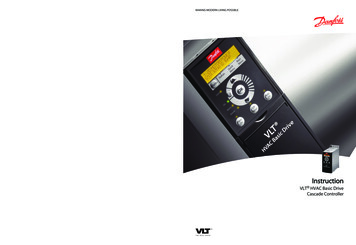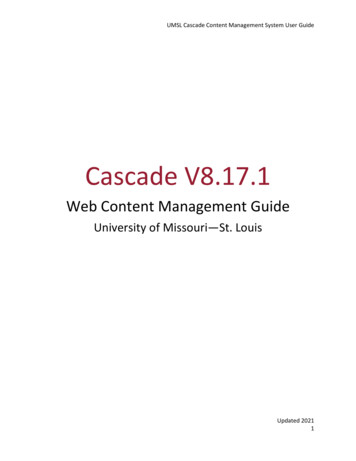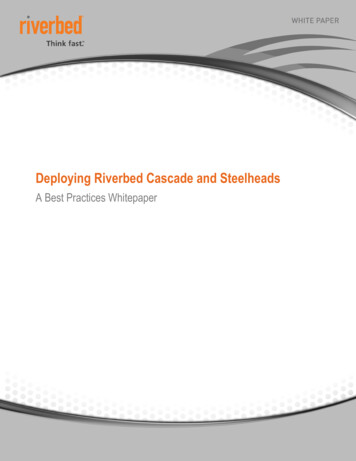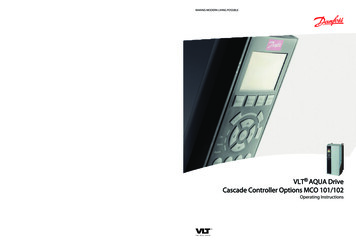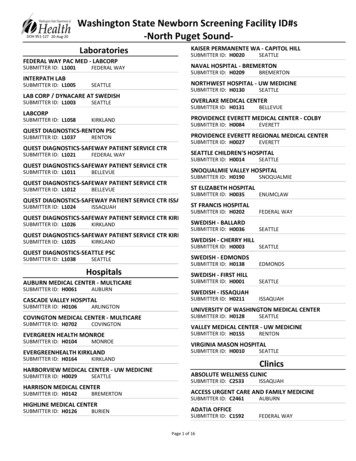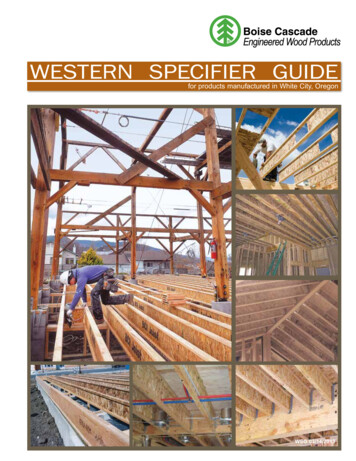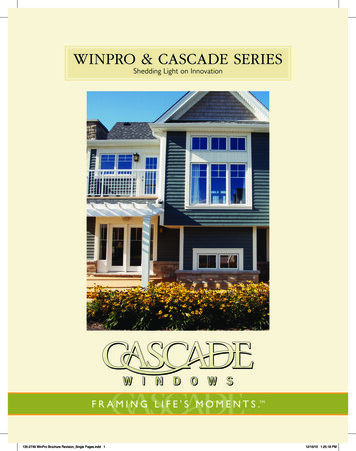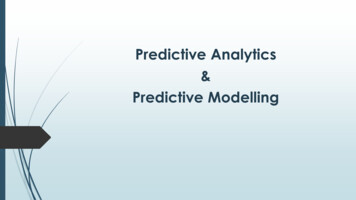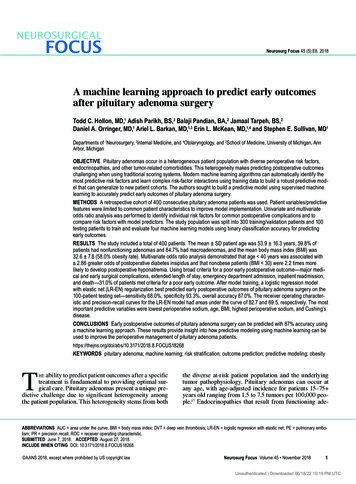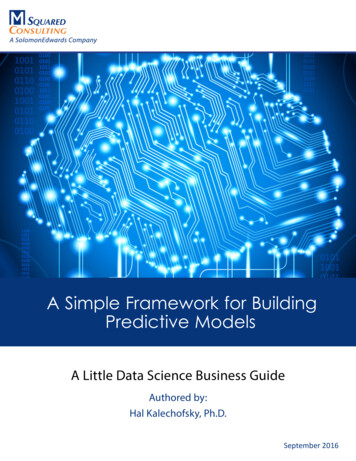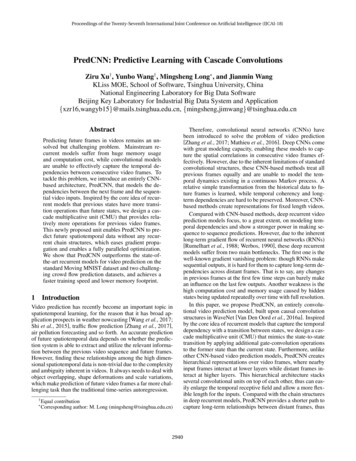
Transcription
Proceedings of the Twenty-Seventh International Joint Conference on Artificial Intelligence (IJCAI-18)PredCNN: Predictive Learning with Cascade ConvolutionsZiru Xu† , Yunbo Wang† , Mingsheng Long , and Jianmin WangKLiss MOE, School of Software, Tsinghua University, ChinaNational Engineering Laboratory for Big Data SoftwareBeijing Key Laboratory for Industrial Big Data System and Application{xzr16,wangyb15}@mails.tsinghua.edu.cn, ing future frames in videos remains an unsolved but challenging problem. Mainstream recurrent models suffer from huge memory usageand computation cost, while convolutional modelsare unable to effectively capture the temporal dependencies between consecutive video frames. Totackle this problem, we introduce an entirely CNNbased architecture, PredCNN, that models the dependencies between the next frame and the sequential video inputs. Inspired by the core idea of recurrent models that previous states have more transition operations than future states, we design a cascade multiplicative unit (CMU) that provides relatively more operations for previous video frames.This newly proposed unit enables PredCNN to predict future spatiotemporal data without any recurrent chain structures, which eases gradient propagation and enables a fully paralleled optimization.We show that PredCNN outperforms the state-ofthe-art recurrent models for video prediction on thestandard Moving MNIST dataset and two challenging crowd flow prediction datasets, and achieves afaster training speed and lower memory footprint.1IntroductionVideo prediction has recently become an important topic inspatiotemporal learning, for the reason that it has broad application prospects in weather nowcasting [Wang et al., 2017;Shi et al., 2015], traffic flow prediction [Zhang et al., 2017],air pollution forecasting and so forth. An accurate predictionof future spatiotemporal data depends on whether the prediction system is able to extract and utilize the relevant information between the previous video sequence and future frames.However, finding these relationships among the high dimensional spatiotemporal data is non-trivial due to the complexityand ambiguity inherent in videos. It always needs to deal withobject overlapping, shape deformations and scale variations,which make prediction of future video frames a far more challenging task than the traditional time-series autoregression.† Equal contributionCorresponding author: M. Long (mingsheng@tsinghua.edu.cn)2940Therefore, convolutional neural networks (CNNs) havebeen introduced to solve the problem of video prediction[Zhang et al., 2017; Mathieu et al., 2016]. Deep CNNs comewith great modeling capacity, enabling these models to capture the spatial correlations in consecutive video frames effectively. However, due to the inherent limitations of standardconvolutional structures, these CNN-based methods treat allprevious frames equally and are unable to model the temporal dynamics existing in a continuous Markov process. Arelative simple transformation from the historical data to future frames is learned, while temporal coherency and longterm dependencies are hard to be preserved. Moreover, CNNbased methods create representations for fixed length videos.Compared with CNN-based methods, deep recurrent videoprediction models focus, to a great extent, on modeling temporal dependencies and show a stronger power in making sequence to sequence predictions. However, due to the inherentlong-term gradient flow of recurrent neural networks (RNNs)[Rumelhart et al., 1988; Werbos, 1990], these deep recurrentmodels suffer from two main bottlenecks. The first one is thewell-known gradient vanishing problem: though RNNs makesequential outputs, it is hard for them to capture long-term dependencies across distant frames. That is to say, any changesin previous frames at the first few time steps can barely makean influence on the last few outputs. Another weakness is thehigh computation cost and memory usage caused by hiddenstates being updated repeatedly over time with full resolution.In this paper, we propose PredCNN, an entirely convolutional video prediction model, built upon causal convolutionstructures in WaveNet [Van Den Oord et al., 2016a]. Inspiredby the core idea of recurrent models that capture the temporaldependency with a transition between states, we design a cascade multiplicative unit (CMU) that mimics the state-to-statetransition by applying additional gate-convolution operationsto the former state than the current state. Furthermore, unlikeother CNN-based video prediction models, PredCNN createshierarchical representations over video frames, where nearbyinput frames interact at lower layers while distant frames interact at higher layers. This hierarchical architecture stacksseveral convolutional units on top of each other, thus can easily enlarge the temporal receptive field and allow a more flexible length for the inputs. Compared with the chain structuresin deep recurrent models, PredCNN provides a shorter path tocapture long-term relationships between distant frames, thus
Proceedings of the Twenty-Seventh International Joint Conference on Artificial Intelligence (IJCAI-18)alleviates the gradient vanishing problem. The output at anytime step does not depend on the computations of all previousactivities, allowing parallelization over all frames. We evaluate our model on the standard Moving MNIST dataset andtwo challenging crowd flow datasets, and show that PredCNNcan yield a competitive prediction accuracy and efficiencyover other state-of-the-art methods.2Related WorkMany recurrent neural networks have been designed for predictive learning of spatiotemporal data based on modelinghistorical frames. [Ranzato et al., 2014] defined a recurrentarchitecture for spatial and temporal correlation discovery enlightened by language modeling technique [Mikolov et al.,2010]. [Srivastava et al., 2015] applied the LSTM framework for sequence to sequence learning. [Shi et al., 2015]extended the LSTM cell by changing normal state transitions to convolution operations so as to capture high-levelvisual representations. This Convolutional LSTM (ConvLSTM) model has become a primary structure in this area.[Finn et al., 2016] developed an action-conditioned modelthat captures pixel motions to predict the next frame. [Lotter et al., 2017] presented a deep predictive coding network(PredNet) where each ConvLSTM layer outputs local predictions and only passes deviations to the following layers. Inspired by two-stream ConvNets [Simonyan and Zisserman,2014] for video action recognition, [Patraucean et al., 2016]and [Villegas et al., 2017] introduced optical flow into recurrent models to describe motion changes. [Kalchbrenner et al.,2017] proposed a probabilistic model, Video Pixel Network(VPN), that makes predictions by estimating the discrete jointdistribution of the raw pixel values in a video and generatingframes with PixelCNNs [van den Oord et al., 2016b]. [Wanget al., 2017] put up a PredRNN architecture with spatiotemporal LSTM unit (ST-LSTM) to extract and memorize spatialand temporal representations simultaneously. Limited by thechain structure of RNNs, these recurrent models suffer fromboth computation burden and parallelization difficulty.Although these RNN-based models enable video predictions at multiple time frames, in many realistic spatiotemporalforecasting applications, making an accurate prediction of thenext frame is far more important than predicting into a distantfuture. Taking traffic flow prediction as an example, commonly used traffic flow images of an urban area are collectedevery half an hour [Zhang et al., 2017] and do not changerapidly. Therefore, the state-of-the-art approaches [Zhang etal., 2016; 2017] particularly designed for this next-frame prediction task have attempted ConvNets, deep residual structures [He et al., 2016] and parametric-matrix-based fusionmechanisms [Zheng, 2015], to enhance their modeling capability of the spatial appearance in the near future. However,these methods deal with the temporal cues by simply feedingsequential input frames into different CNN channels, thus,cannot capture the temporal relationships or maintain the motion coherency to some required extent. Different from theseCNN architectures, our proposed PredCNN model exploits anovel gated cascade convolutional structure to capture temporal dependencies underlying video frames in a logical way.294133.1PreliminariesMultiplicative UnitThe multiplicative unit (MU) [Kalchbrenner et al., 2017] is anon-recurrent convolutional structure whose neuron connectivity is quite similar as LSTMs [Hochreiter and Schmidhuber, 1997]. But differently, it takes input x while discards thehidden representation of all previous states, and thus cannotcapture the spatial and temporal representations simultaneously. There are no recurrent connections in the multiplicative unit, and the computation at each time step does not relyon any previous activities. Its key equations are as follows:g1 σ(W1 x b1 )g2 σ(W2 x b2 )g3 σ(W3 x b3 )(1)u tanh(W4 x b4 )MU(x; W) g1 tanh(g2 x g3 u),where σ is the sigmoid activation function, denotes the convolution operation and is the element-wise multiplication.As an analogy to LSTM unit, g1 , g2 and g3 resemble the output gate, the forget gate and the input gate respectively, and uplays the role of the input modulation gate. W1 W4 andb1 b4 represent the weights and biases of the corresponding convolutional gates, while W denotes all gate parameters.The multiplicative unit is employed as an effective buildingblock in Video Pixel Networks [Kalchbrenner et al., 2017],which endows this model with powerful modeling capabilityof spatial representations without recurrent chain structures.3.2Residual Multiplicative BlockHowever, similar to other LSTM-style structures, the MUsare likely to suffer from gradient vanishing when stacked several times in a deep network. Thus, a residual multiplicativeblock (RMB) has been proposed to ease gradient propagationby [Kalchbrenner et al., 2017]. A RMB consists of two MUsthat are connected end-to-end, one convolutional layer at thebeginning and another at the end, and a residual connectionwhich directly links the input of first convolution layer to theoutput of last convolution layer. Its equations are as follows:h1 W1 x b1h2 MU(h1 ; W2 )h3 MU(h2 ; W3 )(2)h4 W4 h3 b4RMB(x; W) x h4 ,where W1 and W4 are 1 1 convolutions that transform thechannel number of RMB’s internal feature maps. To accelerate computation, RMB first squeezes the size of the featuremaps before feeding them into the two stacked MUs, and thenrestores the channel number to that of the inputs.RMB outperforms individual MU by stabling the gradientchange rate and alleviating the gradient vanishing problem.Also, it provides more expressive spatial representations bymaking the gated convolutional structures deep. But similarto MU, RMB also does not rely on the activities at previoustime steps. It cannot deal with spatiotemporal motions andcannot be directly applied to spatiotemporal prediction tasks.
Proceedings of the Twenty-Seventh International Joint Conference on Artificial Intelligence (IJCAI-18)4PredCNNFtl 1In this section, we present in details the predictive convolutional neural network (PredCNN), which is entirely builtupon gated convolution structures. Initially, this architectureis enlightened by the key idea of modeling both spatial appearances and temporal variations sequentially. To model thetemporal dependency in a well-specified way, we design acascade multiplicative unit (CMU) that predicts future framesbased on previous input frames and guarantees that previousframes must take more operations than future frames. Bystacking CMUs hierarchically into PredCNN, we can modelthe temporal dependencies like the recurrent chain structure.4.1CMU:CascadeMultiplicative Unit The current state depends only on previous states but notvice versa. We guarantee this sequentiality by a cascadeconvolution structure similar to the causal convolution inWaveNet [Van Den Oord et al., 2016a], which computesthe current state by convolving only on previous inputs. Recurrent networks model the temporal dependency bya transition from the previous state to the current state.We model the temporal dependency without using stateto-state transition—instead, we compute the hidden representation of the current state directly using the inputframes of both previous and current time steps, and forcethe previous time step to take more gated convolutions.The diagram of the proposed CMU is shown in Figure 1.Specifically, we first apply MUs to extract the spatial features of each input frame and then add them element-wisely.Then a gate is used to control the flow of hidden representations to the next layer. As we have mentioned before, MUhas LSTM-like structure and can capture a better representation of input frames rather than standard convolutions. TheCMU accepts two consecutive inputs Flt 1 and Flt and generlates one output Fl 1t , where Ft denotes the representation atframe t of layer l. Due to a temporal gap, the two consecutivestates cannot be added directly. Recurrent models bridge thetemporal gap by applying a temporal transition from the previous state to the current state. Instead, we realize this by applying two MUs to the former frame Flt 1 and one MU to thelatter frame Flt . By having such LSTM-like cascade structure,we explicitly guarantee sequential ordering and enhance cascade dependency between the two consecutive frames, whichmay generate more expressive representation Fl 1for them.tThe same as recurrent models, we apply weight-sharing tothe two MUs in the previous state of CMU to reduce modelcomplexity, which also improves the performance potentially2942oσtanhhMUCascade Multiplicative UnitSequential modeling in most successful recurrent models hasa key ingredient: it explicitly models the dependency betweendifferent time steps by conditioning the current state on theprevious state. However, existing convolution-based units including the multiplicative unit (MU) do not support this keydependency mechanism. In this paper, we design a novel cascade multiplicative unit (CMU) based on gated convolutionsto explicitly capture the sequential dependency between theadjacent frames. Our key motivations of CMU are two-folds: h1 h 2MUMUlFt 1FtlFigure 1: Schematic structure of cascade multiplicative unit (CMU),which accepts two inputs of previous and current states and generates an output for the current state. Colored blocks in the same colorrepresent weight-sharing multiplicative units, while white blocks denote gated structures containing convolutions along with non-linearactivation functions, and circles represent element-wise operations.in the meantime. The key equations of CMU are as follows:h1 MU(MU(Flt 1 ; W1 ); W1 )h2 MU(Flt ; W2 )h h1 h2o σ(Wo h bo )Fl 1 ot(3)tanh(Wh h bh ),where W1 and W2 are parameters of orange MUs in the leftbranch and blue MU in the right branch respectively, σ is thesigmoid function, denotes the convolution operation andis the element-wise multiplication. Wo , Wh , bo and bh arethe parameters of the gated convolutions. We adopt Fl 1 tCMU(Flt 1 , Flt ; W) to simplify the representations of aboveequations, where W represents all the learnable parameters.4.2PredCNN ArchitectureWe enable spatiotemporal predictive learning with cascadeconvolutions by building the predictive convolutional neural network (PredCNN). The overall architecture consists ofthree parts: (a) Encoder, which extracts abstract hidden representation of each frame as input to CMUs; (b) Hierarchicalcascade structure, which models the spatiotemporal dependencies using the proposed CMUs hierarchically as buildingblocks; (c) Decoder, which reconstructs the hidden representations of CMUs back to the pixel space and generates futureframes. A schematic diagram of the PredCNN architecture isillustrated in Figure 2. Note that the encoder and the decoderconsist of multiple gated convolutions (RMBs) for modelingspatial appearances.
Proceedings of the Twenty-Seventh International Joint Conference on Artificial Intelligence (IJCAI-18)btXm 1DecoderbtX2DecoderbtXbtX1DecoderDecoderb t 1XHierarchical Cascade StructureBesides the spatial appearances, the temporal dependenciesbetween the next frame and the sequential inputs are the keyto spatiotemporal prediction. Motivated by the big success ofWaveNet [Van Den Oord et al., 2016a] for generating naturalaudios, we propose a hierarchical cascade convolution structure using the proposed CMU unit as building blocks, to capture the temporal relationships over high-dimensional videoframes. By taking the advantages of hierarchical CMUs, thetemporal receptive field is enlarged greatly and the inputs sequence length can be more flexible. When predicting the nextframe, only the input frames before the current time step canbe used, guaranteeing the temporal ordering constraint.Specifically, Figure 2 gives an example of using the previb t 1 . Weous 4 frames Xt 3 Xt to predict the next frame Xpropose two structures of PredCNN for a trade-off of inputsequence length and training time. Figure 2 (top) shows anoverlapping structure, which has 3 layers (other than the encoder and decoder) since the input sequence length is 4. Suppose Flt is the hidden representation of the input frame at timestep t of layer l, and the initial representation captured by theas the final combinationencoder is at layer 0. We have Fl 3tof temporal and spatial features, which will be passed to theb t 1 . Each of the innerdecoder to generate the next frame Xl 1CMU units follows operation Ft CMU(Flt 1 , Flt ; W)as in Equation (3). Figure 2 (bottom) is a non-overlappingstructure of PredCNN with each state used only once in eachlayer, thus has 2 layers (other than the encoder and decoder).We can verify that for a sequence of length T , the overlappingstructure has O(T 2 ) CMUs and the non-overlapping structurehas only O(T ) CMUs. As a tradeoff, the overlapping one ismore accurate and the non-overlapping one is more efficient.DecoderFl 3tWt3mWt33Wt3Wt321Wt3l 2Fl 2t 1 FtWt2mWt23Wt2Wt221l 1Fl 1t 2 Ft 1Wt1mWt13Wt1Wt121l 0Fl 0t 2 Ft 1l 0Fl 0t 1 FtEncoderEncoderEncoderEncoderXtXtXtXt3Wt1l 0Fl 0t 3 Ft 2EncodermWt2l 1Fl 1t 1 Ft21XtOverlapping PredCNNbtXm 1btX2btX1btXDecoderDecoderDecoderDecoderWt2 mWt2 3Wt2 2Wt2 1Wt1 mWt1 3Wt1 2b t 1XDecoderFl 2tFl 1t 2Fl 1tWt1 1l 0Fl 0t 3 Ft 2EncoderEncoderEncoderXtXtXtXt32Wt1l 0Fl 0t 1 FtEncodermWt21EncoderXtNon-overlapping PredCNNFigure 2: The PredCNN architecture, comprised of encoder and decoder to process spatial appearances, and hierarchical cascade multiplicative units (CMUs) to capture spatiotemporal dependencies. Wedesign two variants of PredCNN: overlapping one with higher accuracy (top) and non-overlapping one with higher efficiency (bottom).Encoder and DecoderWe adopt RMB-based encoder and decoder to extract spatial features of input frames and reconstruct the pixel valuesof output frames. As mentioned before, RMB is a residualstructure composed of non-recurrent MUs, making it easy toexplore expressive spatial representations and avoid the gradient vanishing trap even with a deep architecture. We stackle RMB blocks as the encoder and ld RMB blocks as the decoder, where le and ld are two hyperparameters. All framesshare parameters in the encoder and the decoder.To acquire a larger receptive field, we apply the dilatedconvolution [Chen et al., 2016; Yu and Koltun, 2015] to theencoder RMBs as [Kalchbrenner et al., 2017], where the dilation rate is doubled every layer up to the limit 8 and repeated,that is [1, 2, 4, 8, 1, 2, 4, 8, · · · ]. For accurate reconstruction,we do not apply the dilated convolutions to the RMB decoder.2943Remarks: Different from the other CNN-based methods,our PredCNN creates hierarchical representations over videoframes, where nearby input frames interact at lower layerswhile distant frames interact at higher layers. Compared withRNN-based chain structures, our PredCNN architecture enables a highly paralleled optimization during training process,where encoders and decoders for all frames can be trained inparallel. Future states in the hierarchical CMUs only dependon a limited number of hidden representations in the lowerlayers, rather than being trapped by the strong dependencieson computation of previous states in the same layer as recurrent models. This new hierarchical cascade convolution structure significantly reduces the computation cost and memoryusage while successfully capturing the temporal coherence.PredCNN focuses more on capturing spatiotemporal relationship between the next frame and multiple video input frames,which is the main concern of many real applications, such ascrowd flow prediction and air quality forecasting. Note thatPredCNN can also predict multiple future frames by recursively feeding the predicted frames as inputs to future frames.5ExperimentsWe evaluate PredCNN with state-of-the-arts on three datasets,containing both realistic and synthetic images. Datasets andcodes will be released at https://github.com/thuml.
Proceedings of the Twenty-Seventh International Joint Conference on Artificial Intelligence (IJCAI-18)TaxiBJ and BikeNYC [Zhang et al., 2017] are two crowdflow prediction datasets, collected from GPS trajectory monitors in Beijing and New York respectively. We follow thesame experiment settings as in [Zhang et al., 2017] andpredict the citywide crowd movements instead of limitedblocks of several road segments. And most real spatiotemporal prediction applications exploit preprocessed gridded datarather than raw photographs and require prediction accuracyrather than prediction frequency. Besides, we also apply ourmethod to a commonly used video prediction dataset, MovingMNIST, to further validate the superiority of our method.We train all of our models with L2 loss, using Adam optimizer [Kingma and Ba, 2015]. Unless otherwise specified,the starting learning rate of Adam is set to 10 4 , and the training process is stopped after 100 epochs with a batch size of16. We choose the mean squared error (MSE/RMSE) and themean absolute error (MAE) as two basic evaluation metrics.All experiments are implemented in Keras [Chollet and others, 2015] with TensorFlow [Abadi et al., 2016] as back-ends.an hour, with crowd inflow and outflow being regarded astwo frame channels. We rescale the pixel values of the inputdata from [0, 1292] to [ 1, 1], treating them as continuousvariables, and rescale the predicted pixel values back to theoriginal range. The whole dataset contains 22, 484 piecewiseconsecutive frames in four time intervals (1st Jul. 2013 30th Oct. 2013, 1st Mar. 2014 30th Jun. 2014, 1st Mar.2015 30th Jun. 2015, 1st Nov. 2015 10th Apr. 2016).To make quantitative results comparable, we follow [Zhanget al., 2017] and split the whole TaxiBJ dataset into a trainingset of 19, 788 sequences and a test set of 1, 344 sequences.In our experiments, we initially use the previous 4 framesto predict the next crowd flow image. By recursively takinggenerated images as inputs, our model is able to make predictions further into the future. PredCNN has 4 RMBs in theencoder and 6 RMBs in the decoder. The number of channelsin CMUs is 64. Note that a more sophisticated architecture ofthe encoder and decoder might result in better performancebut would also bring in more time cost and memory usage.Baselines We compare the proposed PredCNN with severalbaselines, including not only traditional and deep learningmodels particularly designed for crowd flow prediction, butalso the state-of-the-art approaches originally applied to othervideo prediction tasks. Specific introductions are as follows:Results As shown in Table 1, PredCNN makes a great improvement in prediction accuracy. Its RMSE decreases from16.34 (former best) to 15.17. To assess the effectiveness ofthe proposed cascade multiplicative unit (CMU), we performablation experiments on four PredCNN variant structures. Byreplacing the multiplicative units in the PredCNN architecture with ordinary convolutions (1 Conv2D / 1 Conv2D), theRMSE increases from 15.17 to 15.90. By removing one ofthe weight-shared MUs in the left branch of CMUs (1 MU / 1MU), the RMSE increases from 15.17 to 15.68. By untyingthe two MUs in the left branch (2 untying MUs / 1 MU), theRMSE increases from 15.17 to 15.63. These results validateour design of CMU as an accurate convolutional surrogateto the recurrent unit like LSTM. Two structures of PredCNN(overlapping vs. non-overlapping) will be compared later.We visualize the corresponding frame-wise prediction results in Figure 3. We observe that ST-ResNet, the previous state-of-the-art based on convolutions, tends to underestimate the pixel values, while recurrent models, especiallyPredRNN, are likely to over-estimate them. The proposed ARIMA: Auto-Regressive Integrated Moving Average,a well-known model predicting future time series data. SARIMA: Seasonal ARIMA for periodic time series. VAR: Vector Auto-Regressive, exploring the pairwisecorrelation of all flows and usually being used in multivariate time series analysis. DeepST [Zhang et al., 2016]: a DNN-based spatiotemporal prediction model considering various temporalproperties specified for crowd flow prediction task. ST-ResNet [Zhang et al., 2017]: an updated version ofDeepST with residual structure designed for crowd flowprediction. It further considers the closeness, period,trend as well as external factors all together. VPN [Kalchbrenner et al., 2017]: a well-designed predictive model based on ConvLSTM. Due to the difficultyof reproducing the experimental results of the VPN, wecompare our model with its suboptimal baseline versionthat uses RMBs instead of PixelCNN as its decoder. PredNet [Lotter et al., 2017]: an efficient and effectivemethod particularly designed for one-frame prediction. PredRNN [Wang et al., 2017]: a state-of-the-art recurrent structure modeling spatial appearances and temporal variations simultaneously with dual memory LSTMs.All compared models are evaluated on the same datasets asPredCNN. Experimental results are shown in later sections.5.1TaxiBJSettings and hyperparameters We first evaluate our models on the TaxiBJ dataset, where each frame is a 32 32grid map collected from the taxi GPS in Beijing every half2944ModelRMSEMAEARIMASARIMAVARDeepST [Zhang et al., 2016]ST-ResNet [Zhang et al., 2017]VPN [Kalchbrenner et al., 2017]PredNet [Lotter et al., 2017]PredRNN [Wang et al., .629.679.62PredCNN (1 Conv2D / 1 Conv2D)PredCNN (1 MU / 1 MU)PredCNN (2 untying MUs / 1 MU)PredCNN (CMU, non-overlapping)PredCNN (CMU, .269.22Table 1: Quantitative results of different methods on TaxiBJ.
Proceedings of the Twenty-Seventh International Joint Conference on Artificial Intelligence d truthand predictionstt 1 t 2 t 3 t 4t-3t-2Ground truthand dNetPredNetVPN baselineVPN baselinePredRNNPredRNNInflowModelt 1 t 2 t 3 t 4Frame 2Frame 3Frame 55.4722.69PredCNN15.1717.3519.0420.59Table 3: Frame-wise RMSE of different methods on TaxiBJ.OutflowFigure 3: Samples of TaxiBJ inflow and outflow predictions. Wepredict the next 4 frames each with its previous 4 real frames.PredCNN model usually gives more accurate predictions. Forinstance, the hot areas in yellow denote high crowd flow intensities, where possibly the traffic jam happens. For theseregions, the prediction by ST-ResNet at time t 1 is obviously smaller than the ground truth, indicating a relativelyhigh false negative rate. On the opposite, PredRNN has ahigh false positive rate as it often predicts higher crowd flowvalues, which is especially obvious at time steps t 3 andt 4. By contrast, our PredCNN model balances the F-scoreand predicts more accurate hot areas of the crowd flow.Furthermore, we compare PredCNN’s training time (untilconvergence) and memory usage with those of the baselinemodels (see Table 2). Our model takes less memory footprint and yields a higher convergence speed than the state-ofthe-art recurrent methods. It is worth noting that ST-ResNetshares similar characteristics, which strongly proves the computation efficiency of the CNN-based models. PredCNNwould thoroughly show its strength of highly paralleled optimization when dealing with longer spatiotemporal sequences.Table 1 and Table 2 show the comparison of two PredCNNstructures (overlapping and non-overlapping). They have tinyquantitative differences on RMSE and memory usage buthuge distinction on training time. With acceptable RMSEloss, we can substantially decrease the training time. This advantage of the non-overlapping structure is more prominentfor longer input sequences in the following section 5.3.Besides one-frame prediction, we recursively apply ourPredCNN model trained with 4 inputs and 1 target to frameby-frame prediction task and compare it with the other videoTraining 683.7325.3340.61627236916012497PredCNN (overlapping)PredCNN (non-overlapping)197.0137.413451058ModelFrame 1Table 2: Training time and memory usage on TaxiBJ.prediction methods (see Table 3). At inference time, we onlyshow our model 4 input frames and make it resemble the recurrent models to predict the next 4 frames in a rolling style.PredNet, as a strong competitor for one-frame prediction, performs worse in this scenario. Evidently, PredCNN achieves abetter performance than all the others with lower RMSEs.5.2BikeNYCSettings and hyperparamete
dictive learning of spatiotemporal data based on modeling historical frames.[Ranzatoet al., 2014] defined a recurrent architecture for spatial and temporal correlation discovery en-lightened by language modeling technique[Mikolovet al., 2010]. [Srivastavaet al., 2015] applied the LSTM frame-work for sequence to sequence learning.[Shi et al., 2015]
